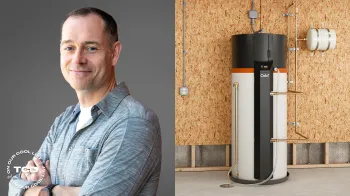Stanford researchers are tinkering with Medusa-like powers by turning heat-trapping air pollution into stone.
Specifically, they are empowering common minerals to store the gases, rendering them incapable of warming the planet and causing increased risks for severe weather, public health problems, and other concerns noted by NASA and the World Health Organization. The work was detailed in a university news release.
The approach uses high heat to transform the minerals into rocks that can "spontaneously pull carbon from the atmosphere and permanently sequester it," per the statement.
The rocks can be made at a low cost with kilns already used in cement production. The technique speeds up to only hours a natural process that can take hundreds or thousands of years — silicates reacting with water and carbon dioxide to form harmless carbonate rock. Scientists have long been searching for a way to expedite the fascinating phenomenon, all according to Stanford.
"The Earth has an inexhaustible supply of minerals that are capable of removing CO2 from the atmosphere, but they just don't react fast enough on their own to counteract human greenhouse gas emissions," professor Matthew Kanan, the study's senior author, said in the release. "Our work solves this problem in a way that we think is uniquely scalable."
The team swapped out sand for some specific minerals before baking them to produce alkaline rocks that react with acidic CO2 in the air. The minerals are abundant and are often mining byproducts. The creation trapped and stored pollution within a couple of hours of testing. Trials replicating natural air exposure had results in weeks or months, all per Stanford.
Watch now: Giant snails invading New York City?
The experts estimated they could make 33 pounds of material in a week. However, millions of tons a year would be needed to have a global impact, the report added.
Capturing air pollution from the atmosphere and storing it is a solution to planet warming being used by Nestlé and other companies. The U.S. government even invested at least $1.2 billion into direct air capture efforts.
But a separate Stanford report is an ironic soot cloud over the concept. It would be better to focus on a widespread switch to renewable energy than to invest in remediation, in large part due to costs and associated emissions, per the summary.
The rocky project offers upsides over air filtering.
TCD Picks » Upway Spotlight

|
Do you think America could ever go zero-waste? Click your choice to see results and speak your mind. |
"Our process would require less than half the energy used by leading direct air capture technologies, and we think we can be very competitive from a cost point of view," Kanan said in the Stanford report.
However, the process isn't entirely clean. The researchers borrowed from dirty cement-making methods by using a kiln. It is widely reported that the cement industry accounts for about 8% of the Earth's heat-trapping fumes.
Stanford is also looking into electric kilns that can be used in place of fossil burners. Even so, each ton of kiln-fired rock can remove about a ton of CO2 after accounting for fuel, all according to the release.
Jailing air pollution is being studied in other labs as well. England-based experts are working on a special molecule that can harmlessly cage the gases.
For Stanford's part, the team said its pollution-wrangling product could be spread on farm fields, also serving as a lime replacement. And there's plenty of work for the invention, as we produced 37 billion tons of CO2 from burning fossil fuels last year. The good news is that there's enough material to create rocks to catch all of it and more — "enough to permanently remove far more CO2 than humans have ever emitted," postdoctoral scholar Yuxuan Chen said in the summary.
Nearly everyone can play a part in preventing harmful planet warming. Unplugging your unused chargers and devices before bed each night can cut your energy bill while saving loads of power each year.
Join our free newsletter for weekly updates on the latest innovations improving our lives and shaping our future, and don't miss this cool list of easy ways to help yourself while helping the planet.


















